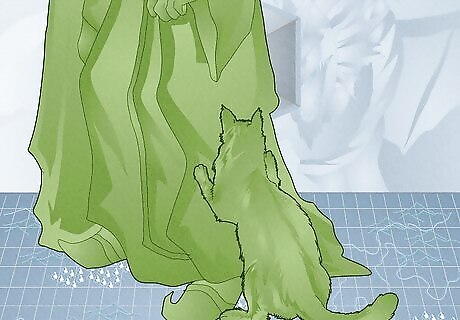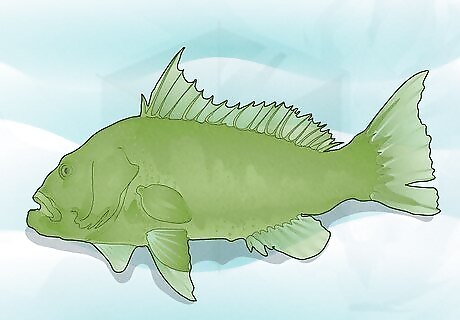
views
- Find Familiar is a 1st-level conjuration spell that lets your character summon a fey, fiend, or celestial spirit in the shape of an animal.
- Familiars have a telepathic connection with their summoners and can act independently in combat, though they always follow their summoner’s directions.
- A familiar can be a small creature such as a bat, cat, crab, frog, fish, hawk, lizard, octopus, owl, poisonous snake, rat, raven, sea horse, spider, or weasel.
Find Familiar Spell Overview

Find Familiar is a 1st-level spell that lets you summon a familiar. In D&D 5e, familiars are magical spirits (either fey, fiends, or celestials) that take the shape of animals. They’re independent creatures but always follow their summoner’s commands; because they’re spirits summoned by a spell, familiars don’t require an animal handling check to influence. They also have more abilities than the average D&D animal, making Find Familiar a useful spell. Casting time: 1 hour School: Conjuration Range: 10 feet (meaning the familiar appears within 10 feet of its summoner) Target: An unoccupied space within range Components: Verbal, somatic, and material Duration: Instantaneous
How does the Find Familiar spell work?

Cast Find Familiar as a ritual with the required material components. In D&D 5e, ritual spells are a specific type of spell that can be cast without consuming a spell slot but take 10 extra minutes to cast as a result. Find Familiar takes 1 hour to cast already, so adding 10 minutes to that casting time usually isn’t a big deal. The spell also requires material components to cast: 10 gold pieces’ worth of charcoal, incense, and herbs that must be burned in a brass brazier. Because Find Familiar has a minimum casting time of 1 hour, it’s important to plan ahead when you want to cast it. It’s not the kind of spell you’ll be able to cast in the heat of battle. Each time you cast Find Familiar, you’ll need to have enough of the material components on hand to do so. Make sure your D&D character buys the components they need in advance! If you’re not sure where to find components for the spell, talk to your DM. In-game, they can likely direct your character to a shop with everything they need.

Choose your familiar’s species and appearance. Once the spell is cast, your PC’s (player character’s) familiar will appear within 10 feet of them, and you get to make a couple of choices: what type of spirit they are (fey, fiend, or celestial), as well as what kind of animal they are. The choice between fey, fiend, and celestial is mainly for flavor, as it doesn’t really change anything, but the choice between animals does affect their strengths, weaknesses, and abilities. A familiar can only take the form of a small creature, from an owl or raven to a cat, fish, or snake. For all the options (and an overview of their abilities), see the list below. Even though your PC’s familiar takes a single form after casting the spell to summon them, you can choose to change the familiar’s form each time you cast the spell. So, just because you regularly summon the familiar as a cat, doesn’t mean you can’t recast the spell and summon them as an octopus for an underwater adventure!

Familiars can communicate telepathically and act in combat. After a familiar is summoned, they gain a telepathic connection with your PC so long as they’re within 100 feet of each other. As an action, your PC can also choose to see through their familiar’s eyes and hear what their familiar hears until their next turn, also gaining any special senses their familiar has. In combat, familiars act on their own turns but obey their summoner’s commands and can even be used to cast spells. It’s important to note that, while seeing through a familiar’s eyes, your character becomes blind and deaf with regard to their own senses. If you cast a spell using your familiar, it must be a spell with a range of touch (meaning you need to touch an enemy to cast it on them), and your familiar must be within 100 feet of your PC. Spells are cast on your turn in combat, but your familiar must use their reaction to cast it. When a spell requires an attack roll (meaning you need to roll to see if you hit an enemy successfully), you can still use your own attack roll modifier for it.

Your PC can dismiss their familiar as an action and resummon them. When you dismiss your familiar as an action, it’s only temporary—and you can choose to make them reappear in any unoccupied space within 30 feet of your character. While dismissed, the familiar simply waits in a harmless pocket dimension to be summoned once more. However, if the familiar drops to 0 hit points, it disappears and can only return when the Find Familiar spell is cast again. Hit points are the value in D&D 5e that measures a creature’s health and remaining life force. Creatures (including familiars) lose hit points as they take damage. Remember: if you cast the Find Familiar spell while a familiar is already summoned, you won’t get another one—there can only be 1 familiar at a time. Familiars can also optionally be dismissed forever—but if you just want to change a familiar’s form, you don’t need to dismiss the original forever. Just cast the spell again and choose to change them!
How to Use Your Familiar

Have your familiar act as a scout or spy. Since PCs can see through their familiar’s eyes (and hear what they hear), familiars make excellent scouts. They can run ahead while your PC is exploring and find traps, treasure, or enemies trying to set an ambush. Alternatively, they can spy on other characters for you and pick up valuable information that your PC might not learn otherwise! For example, if a political council was meeting, but your PC wasn’t allowed to attend, they could send their familiar to hide in the room and pick up tidbits of the conversation through their telepathic connection. However, it’s important to remember that because your PC can’t see or hear with their own senses while using their familiar, they’re vulnerable during that time. If possible, try asking another PC in the D&D party to guard your character while they’re looking through their familiar’s eyes. That way, if an enemy finds your PC, they won’t be completely helpless.

Avoid dangerous enemies by casting spells through your familiar. Say you’re in a battle and want to hit a tough enemy with a spell attack, but you don’t want to get close enough for them to attack you in retaliation once the spell is cast. That’s where familiars come in! If you position your familiar closer to that enemy, you can cast the spell through your familiar—and, ideally, avoid any attacks in the process. For example, the Inflict Wounds spell is super useful for dealing damage but has a range of touch. Therefore, if you wanted to cast Inflict wounds on an enemy but were afraid of that enemy attacking you, you might send a hawk familiar flying over to them so it could land on the enemy and cast Inflict Wounds for you.

Give yourself the “help” action through your familiar. In D&D 5e, there are plenty of actions a creature can take according to its class, but a few are universal. The “help” action means choosing to help another creature and giving them advantage on the skill check they’re making. So, you can basically say that your familiar is giving you advantage during high-stakes skill checks that you really want to succeed on. For example, if you’re making an investigation check and trying to search for documents in an enemy’s lair, you could say that your familiar is looking too and giving you the help action on your check. Having advantage simply means that you’re able to roll your dice twice on a skill check, attack, or saving throw and take the higher result, giving you a better chance of success.

Use your familiar to snatch useful items and administer potions. Since familiars are solid, physical creatures (even though they’re really magical spirits), they can interact with objects when needed. So, your familiar could grab an important magical item for you in the middle of a fight or sneakily grab it from a nearby bandit camp! Familiars can also administer potions, which means your PC doesn’t have to spend an action doing it themselves. For example, if your PC is wounded in a fight and needs a healing potion, their familiar could quickly give them the potion.
Which familiars can you pick?

Bat Bats have a flying speed of 30 feet per round (and a much slower walking speed of 5 feet per round). They also have blindsight for 60 feet (based on an actual bat’s echolocation abilities), allowing them to sense creatures and objects that they can’t see. Finally, they have advantage on perception checks that are hearing-based because of their keen hearing abilities, making them excellent scouts.

Cat Cats are a fantastic choice when you want a familiar that excels at stealth. They have a slightly faster-than-average walking speed at 40 feet per round and a climbing speed of 30 feet. Cats also have better bonuses to both stealth and perception checks than other familiars and a higher passive perception as well, which is why they’re so versatile and useful in covert situations. Passive perception determines a creature’s ability to detect things (like traps and ambushes) without actively trying to do so.

Crab Crabs are aquatic, so they gain a swimming speed of 20 feet per round (and an equivalent walking speed), although it should be noted that they’re definitely not the fastest aquatic familiar available. They also get blindsight out to 30 feet around them, allowing them to “see” despite their poor eyesight. While not very effective on land, they work well with underwater-themed D&D campaigns.

Fish (Quipper) A quipper is a type of fish—though, assuming your DM will allow it, you could likely say your familiar looks like a different kind of fish and not necessarily a quipper. Nonetheless, a fish familiar is another solid choice for an aquatic D&D campaign, as it has a swim speed of 40 feet per round. Unfortunately, it can’t move around on land at all, making it a tough choice for any other setting.

Frog Frogs have similar stats to crabs in D&D 5e, though they have darkvision (meaning they can see well in the dark) out to a range of 30 feet instead of blindsight. They can also jump up to 10 feet (or 5 feet high) without taking a running jump, and they breathe both air and water.

Hawk Hawks make great options if you’re looking for a familiar that can be a reliable scout. They have a fast flying speed (60 feet per round) and advantage on perception checks that rely on sight, with a relatively decent bonus to their perception as well compared to many other familiar options.

Lizard Lizards have darkvision out to a range of 30 feet and a climbing speed of 20 feet per round. Beyond that, however, their ability scores aren’t as high as some of the other familiar options, making them a fun choice but not as effective if you’re a player who likes to take those factors into consideration.

Octopus Like fish, octopus familiars are only aquatic, so they’re not much help on land. Nonetheless, they make good companions when underwater, especially because they have bonuses to stealth and perception and darkvision out to a range of 30 feet.

Owl Owl familiars have similar abilities to hawks—and, in some cases, their senses are even superior. They have bonuses to stealth and perception, a fly speed of 60 feet per round, and darkvision out to a range of 120 feet, making them the best airborne familiar for scouting both during the day and at night.

Poisonous snake On top of their normal “walking” (slithering) movement speed, poisonous snakes also get an equivalent swimming speed of 30 feet per round and blindsight out to a range of 10 feet. However, the real thing that sets them apart is their attack; they have a bite that deals up to 2d4 poison damage to enemies.

Rat With darkvision out to a range of 30 feet, rat familiars are capable of seeing in the dark but have fairly average ability scores (and no additional bonuses to any skills, like stealth or perception). Therefore, they’re not the most tactically advantageous choice of familiar, but can still be fun if they fit the aesthetic of your character.

Raven Raven familiars have a fly speed of 50 feet per round, which is decent but not as high as the other familiars capable of flight. However, they make up for it with a bonus to their perception skill and the “mimicry” ability, which allows them to mimic simple sounds that they hear (although other creatures can try to see through a raven’s mimicry with an insight check).

Sea horse Sea horse familiars, like fish and octopi, aren’t much use on land as they only have a swim speed of 20 feet per round. Given that their swim speed is slower than that of a fish and they don’t have any bonuses to stealth, perception, or darkvision like an octopus, sea horses aren’t the best tactical choice, though they can certainly make for colorful familiars.

Spider Spider familiars are especially well-suited to dungeon-crawl campaigns (which essentially means the campaign is mainly devoted to exploring dungeons, fighting monsters, and looting). They have a bonus to their stealth skill, darkvision out to a range of 30 feet, and the ability to quietly scuttle across ceilings and scout ahead in a dim, gloomy dungeon.

Weasel Weasels don’t have the best ability scores out of the different familiar options, but they make up for it with the largest bonus to stealth that a familiar can have and a decent bonus to their perception skill as well. They have an average walking speed of 30 feet per round. All in all, they’re a decent familiar choice if you anticipate needing to sneak around.

Variant familiar Variant familiars aren’t included in the original Find Familiar spell description for D&D 5e. However, additional rulebooks and bestiaries added to 5e over the years contain information about variant familiars that can optionally be added to your D&D game. However, many variant familiars are either unique to a particular D&D world and setting or much stronger than the base options, so be sure to consult your DM before choosing one! Abyssal chicken: Abyssal chickens are specific to the Baldur’s Gate: Descent into Avernus 5e adventure book. They’re tiny demons that look like chickens but have enough resistances and abilities to make them effective in battle. Almiraj: An almiraj, found in the Tomb of Annihilation adventure book, is essentially a rabbit with a unicorn’s horn on its forehead. They move super fast (50 feet per round) and have a bonus to their perception skill. Anvilwrought raptor: Found in the Theros campaign setting for 5e, these are large, living metal birds with a high armor class (meaning they’re hard to hit in battle) and an extended telepathic distance of 1 mile rather than 100 feet. Flying monkey: Also in Tomb of Annihilation, flying monkeys have a flying and climbing speed (30 feet and 20 feet per round, respectively), making them swift and agile. Gazer: These powerful familiars are from the Volo’s Guide to Monsters 5e sourcebook. They’re small beholders and, as such, can shoot dazing, fear, frost, and telekinetic rays from their eyestalks. Tressym: Tressyms are much like cats! The only difference is that these feline familiars from the Storm King’s Thunder adventure also have wings (with a flying speed of 40 feet per round) and the ability to detect poison and invisibility.
Who can cast Find Familiar in 5e?

Wizards are the only class with Find Familiar on their spell list. In D&D 5e, a class determines a character’s profession and skillset—and the wizard class is the only one with Find Familiar automatically on the list of spells they can choose to learn. So, if your PC is a wizard (an arcane spellcaster who learns through intense study), you can simply choose for them to learn and prepare the Find Familiar spell.

Pact of the Chain warlocks get to summon different familiars. If you play D&D as a warlock (an arcane spellcaster who gets their powers by making a pact with a powerful entity), then you also get to choose what kind of boon your PC gets for making that pact. The Pact of the Chain lets your PC learn the Find Familiar spell and choose one of the normal animal forms for their familiar or choose one of the following special forms: Imp: Imps are a form of lesser devil, and as such, they gain damage resistance to cold, nonmagical weapons and magic as well as the ability to turn invisible. Pseudodragon: Pseudodragons are essentially tiny dragons! They have advantage on perception checks relying on sight, magic resistance, and a special sting attack that can render enemies unconscious. Quasit: Quasits are small demons with resistance to cold, fire, lightning, and nonmagical weapon damage. They also have darkvision out to 120 feet and an immunity to poison damage. Sprite: Sprites are tiny fey creatures with a flying speed of up to 40 feet per round. They have a very high stealth bonus and the ability to turn invisible, making them fantastic scouts.

Any PC can gain the spell through the Magic Initiate feat. If you’re not playing a wizard or warlock, it’s still very possible to give your PC the Find Familiar spell! Simply take the Magic Initiate (Wizard) feat when your character levels up; the feat gives PCs access to 2 cantrips and a single 1st-level spell from the wizard spell list (and Find Familiar is a 1st-level spell). Any class can do it, from bard to barbarian! Keep in mind that if you play a ranger or druid, you may have an animal companion feature as part of your class as well, making the Magic Initiate feat unnecessary. Beastmaster subclass rangers have animal companions, which don’t have all the magical abilities of familiars, but they’re generally tougher and more capable of fighting in combat. In the rulebook Tasha’s Cauldron of Everything, druids gain access to an optional feat called Wild Companion, which grants them access to the Find Familiar spell (without needing to use any material components).



















Comments
0 comment